Wireless Telegraphy On Steamships
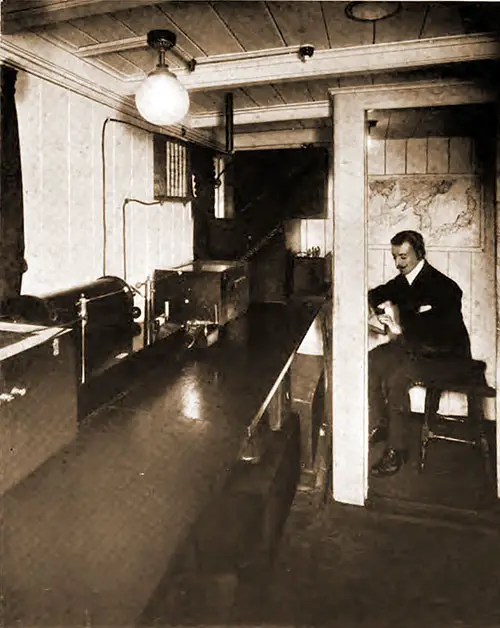
View of the Marconi Room on a Cunard Line Ocean Liner circa 1910. GGA Image ID # 17d57010cf
Wireless telegraphy is, in theory, closely allied to heliography, or signaling with flashes of light. However, the light used is produced electrically and is invisible to the naked eye, owing to the fact that it is made up of very long waves, called Hertzian waves, which vibrate too slowly to affect the retina. The eye can only discern waves which make from 4,000 billion to 7,000 billion vibrations per minute.
However, the Hertzian ray resembles light in that it can be reflected by a metallic plate and can be refracted by a prism of pitch, can be brought to a focus with a pitch lens, and maybe polarized. Owing to the great length of the Hertzian waves, almost all substances are transparent to them.
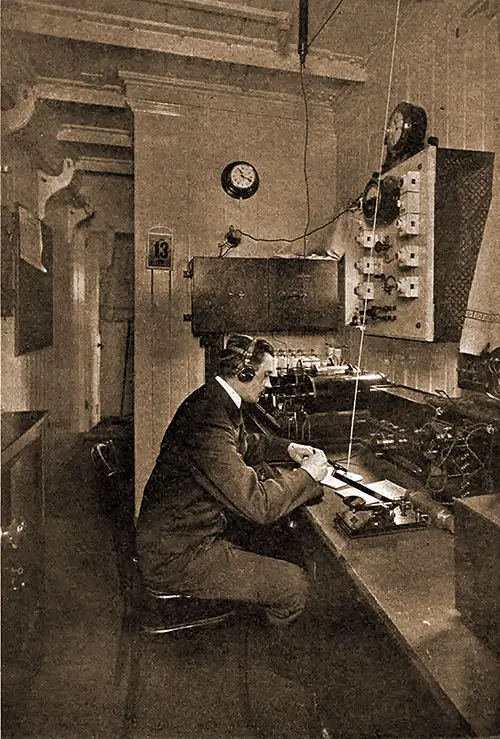
The Wireless Operator Is a Power in Time of Need, Flashing His "C. Q. D." or "S. O. S." Into Space. GGA Image ID # 17b383844d
The Hertzian waves were discovered by Professor Heinrich Hertz, a young German philosopher, during his experiments with Leyden jars' spark discharge and of the Ruhmkorff coil in 1886 and 1887.
He found that when a spark leaped the gap between the terminals, electric oscillations took place in these terminals, which set up magnetic waves in the surrounding space, capable in turn of setting up similar oscillations in any adjacent conductor lying at an angle to them.
The waves were detected by using a "resonator," which was merely a circle, or a rectangle of copper wire formed with a gap in one side.
When the induction coil was in operation, and the resonator coil was held near the coil, a tiny stream of sparks would leap across the resonator gap.
To better understand this phenomenon take as a crude example two vertical rods in a pool of water and on each afloat free to slide vertically on the rod.
Now, if one of these floats be moved up and down upon its rod, it produces waves in the water just as the electric oscillation produces waves in the ether.
These spread out in all directions and on reaching the other float cause it to oscillate up and down, just as the magnetic waves produce electric oscillations in the resonator.
Without going into a detailed history of the development of wireless telegraphy from Hertz's experiments, it may be stated that the essential difference between the apparatus used by Hertz in his experiments and the several systems now commonly in use lies in the receiver.
The transmitter is practically the same. A vertical wire called the antenna is connected to one terminal of the coil, and the other terminal is connected with the earth, the purpose being to increase the electrical capacity of the terminal rods and produce larger waves.
Instead of producing the oscillations by means of an induction coil, they are now ordinarily produced by a dynamo and a step-up transformer except for telegraphing over short distances.
But even with these changes, we would not be able to telegraph over any appreciable distance is dependent upon the Hertz resonator for receiving a message, for, owing to the fact that the waves spread out in all directions from the transmitting antenna, the receiving antenna is acted upon by a very small proportion of the power expended by the transmitter, and this proportion decreases very rapidly as the distance between the transmitter and the receiver increases.
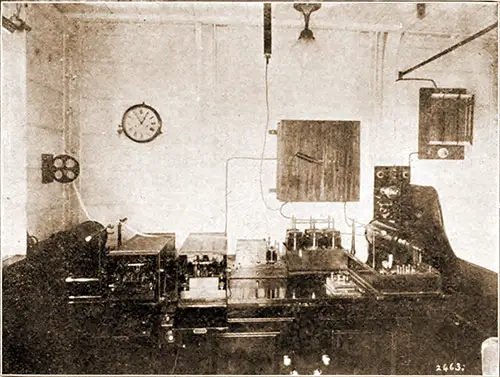
Marconi Station on an Ocean Liner circa 1907. GGA Image ID # 17d3c65b46
In order then to detect the rays at long distances, a very sensitive instrument called the "coherer" has been invented. The coherer in its usual form consists of a glass tube with two metal pistons fitted therein, between which a quantity of nickel filings is placed.
The latter forms an imperfect electrical contact between the pistons and takes the place of the spark gap in the receiving antenna.
When the oscillations are set up in the antenna by the Hertzian waves, they break through the coherer's imperfect contact due to their high pressure or voltage, causing the filings therein to cohere or string together and thus produce a much better electric path through the coherer. The action is microscopic and cannot be detected with the naked eye.
However, the coherer, aside from being a part of the antenna circuit, is also made a part of a local battery circuit, which contains a telegraph receiver, and whenever the electric oscillations open a good path through the filings for the local circuit, the telegraph instrument will be energized by the local battery only.
In order to break this path after the oscillations have ceased, or, in other words, to cause the filings to decohere, obey are constantly jarred apart by means of the "tapper," which is, in reality, an electric bell with the gong removed and the clapper striking the coherer tube instead.
Carbon granules may be substituted for metallic filings, and in this case, no tapper is necessary, the coherer being self-restoring. In transmitting messages, a telegraph key in the primary circuit of the induction coil is operated according to the usual Morse code, and this causes sparks to leap the spark gap at corresponding intervals.
These signals will then be transmitted by the Hertzian waves to the receiving station, where they will be recorded by the telegraph receiver.
The coherer is not by any means the only wave detector in use. Every wireless telegraph company has one or more different types of detectors.
Wireless Information On Steamships
Travelers by the principal passenger vessels listed have at their disposal when at sea, a Public Telegraph Service in the Marconi Wireless Telegraph System, working in conjunction with the ordinary Inland Telegraphs and the International Cables throughout the World.
Telegrams are accepted on board ship for transmission to all parts of the world through such Marconi Telegraph Stations as the vessel may pass. Through rates can be obtained from the Pursers and Operators on the ships.
Telegrams are also accepted for passing ships fitted with Marconi Telegraphs, either for delivery on board or for re-transmission through shore stations.
Prepaid telegrams for transmission to ships at sea are accepted at the offices of the Postal and Western Union Telegraph Companies, and at the Marconi Company's Head Office, 27 William Street, New York, where full information can be obtained.
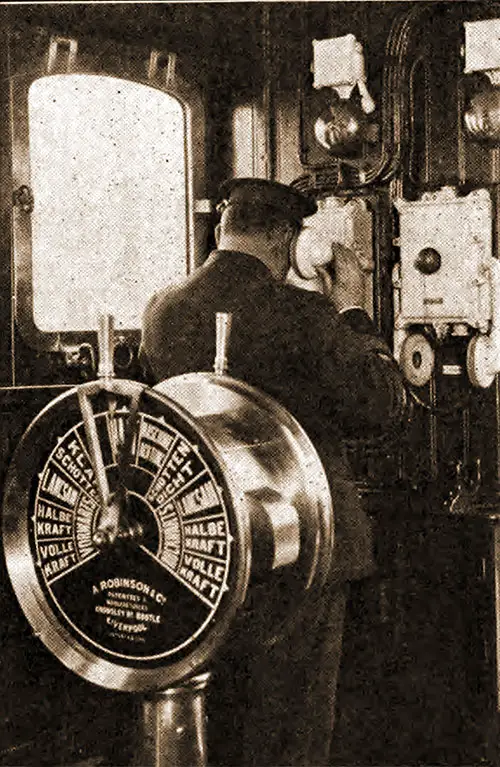
Engine Telegraphs on the Bridge and Other Parts of the Vessel. GGA Image ID # 17b46bfc9e
The Company's Shore Stations in North America are situated at Sea Gate, L. I., Sagaponack, L. I., Siasconset, Mass., and communicate with the vessels listed below at times when they are four, eight and fourteen hours respectively from New York.
The Canadian Marconi Company's Station at Camperdown, N. S., is also available and may be used when vessels are 36 hours from New York.
A charge is made for the first ten words or less and at a reduced rate for each word over ten. The address and signature are not charged for.
For 10 words or less.
- Via Sea Gate $2.00
- Via Sagaponack $2.25
- Via Siasconset $3.00
- Via Camperdown $4.00
The above rates are the Wireless rates; senders will pay in addition thereto, the regular tolls to or from the points named.
The vessels marked with an asterisk (*) may be reached at any time within 60 hours from New York by routing telegrams via this Company's High-Power Station at South Wellfleet, Mass.
The charge for such messages is $5.00 for 10 words or less, plus the regular tolls to South Wellfleet. A new station at Palm Beach has just been opened, rate $2.00.
Partial List of Marconi Telegraph Offices on Shipboard.
- *Batavia
- Berlin
- *Blucher
- *Bulgaria
- Caledonia
- California
- *Campania
- Canonic
- *Carmania
- Adriatic
- Alice
- America (Italian)
- *Amerika
- Ancona
- Arabic
- Argentina
- Baltic
- Barbarossa*
- Caronia
- Carpathia
- Cedric
- Celtic
- *Chicago
- *Cleveland
- Columbia
- Cordova
- Corsican
- Cretic
- Cymric
- *Deutschland
- Dominion
- Duca D'Abruzzi
- Duca de Genova
- Empress of Britain
- Empress of China
- Empress of India
- Empress of Ireland
- Empress of Japan
- *Etruria
- Europa
- Finland
- Florida
- Florizel
- Friedrich der Grosse
- Furnessia
- *George Washington
- Germania
- *Graf Waldersee
- Grosser Kurfurst
- Grampian
- *Hamburg
- Hesperian
- Indiana
- Ivernia
- *K'rin Aug. Vic
- *K'r Wilhelm II
- *K'r Wm. der Grasse
- Konig Albert
- Konigen Luise
- *Kronpz. Wilhelm
- *Kronpz. Cecilie
- Kroonland
- Lapland
- *La Bretagne
- *La Gascogne
- *La Lorraine
- *La Provence
- *La Savoie
- *La Touraine
- Laura
- Lazio
- Liguria
- Lombardia
- *Lucania
- *Lusitania
- Madonna
- Main
- Majestic
- M. Washington
- *Mauretania
- Mendoza
- Minneapolis
- Minnehaha
- Minnetonka
- Minnewaska
- *Moltke
- Neckar
- *New Amsterdam
- New York
- *Noordam
- Nord America
- Oceania (Ital.)
- Oceanic
- Pannonia
- *Patricia
- Pennsylvania
- Philadelphia
- *Potsdam
- *President Grant
- *President Lincoln
- *Pretoria
- Prism di Piemonte
- Prinz Fried. W'm
- Prinzess Alice
- Prinzess Irene
- Re d'Italia
- Regina d'Italia
- Rhein
- Roma
- Romanic
- Rosalind
- *Rotterdam
- *Ryndam
- Sannio
- San Giorgio
- San Giovanni
- Sardegna
- Saxonia
- Sicilia
- *Statendam
- St. Louis
- St. Paul
- Taormina
- Teutonic
- Tomaso di Savoie
- Tunisian
- Ultonia
- Umbria
- Vaderland
- Venezia
- Verona
- *Victorian
- *Virginian
- Zeeland
The company is prepared to announce the arrival of the above vessels 48 to 4 hours before docking at a uniform charge of $1.50 per vessel.
Requests for these reports must be made at the Company's Head Office, 27 William St., New York.
NOTE.—Telegrams routed via South Well-fleet, must be filed with the Western Union Telegraph Company, or at the Marconi Company's offices.
Sending Cables on Landing
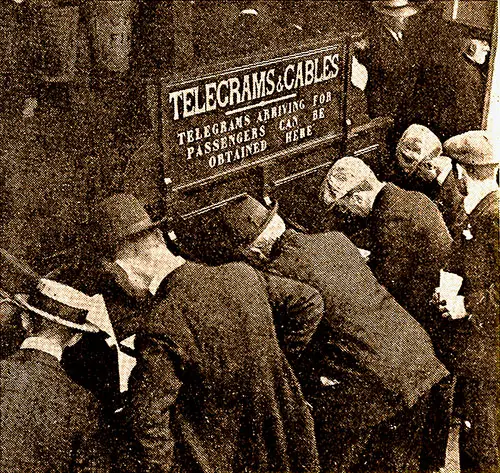
Passengers and Newsmen Busy Sending Telegrams and Cables at Fishguard circa 1910. GGA Image ID # 17b3bc7659
Immediately on landing, the traveler can avail himself of the opportunity to send cablegrams. A registered cable address should be left at home in order to save expense, for every word is charged for.
Usually, abroad, the amount of the fee paid must be indicated by postage stamps attached to the telegram.
Sometimes a receipt for the charges is furnished for a small fee of, say, four cents of our money. Cable blanks will be found on all the steamers and at all the landings.
Great care should be taken to count the words and see that there is no overcharge in sending these cablegrams. Be sure to count your change; this is particularly necessary at these cable and telegraph offices where the volume of business is so great.
